Economy: India 1
Several sections from this page have been shifted to Economy: India 2 (Ministry data)
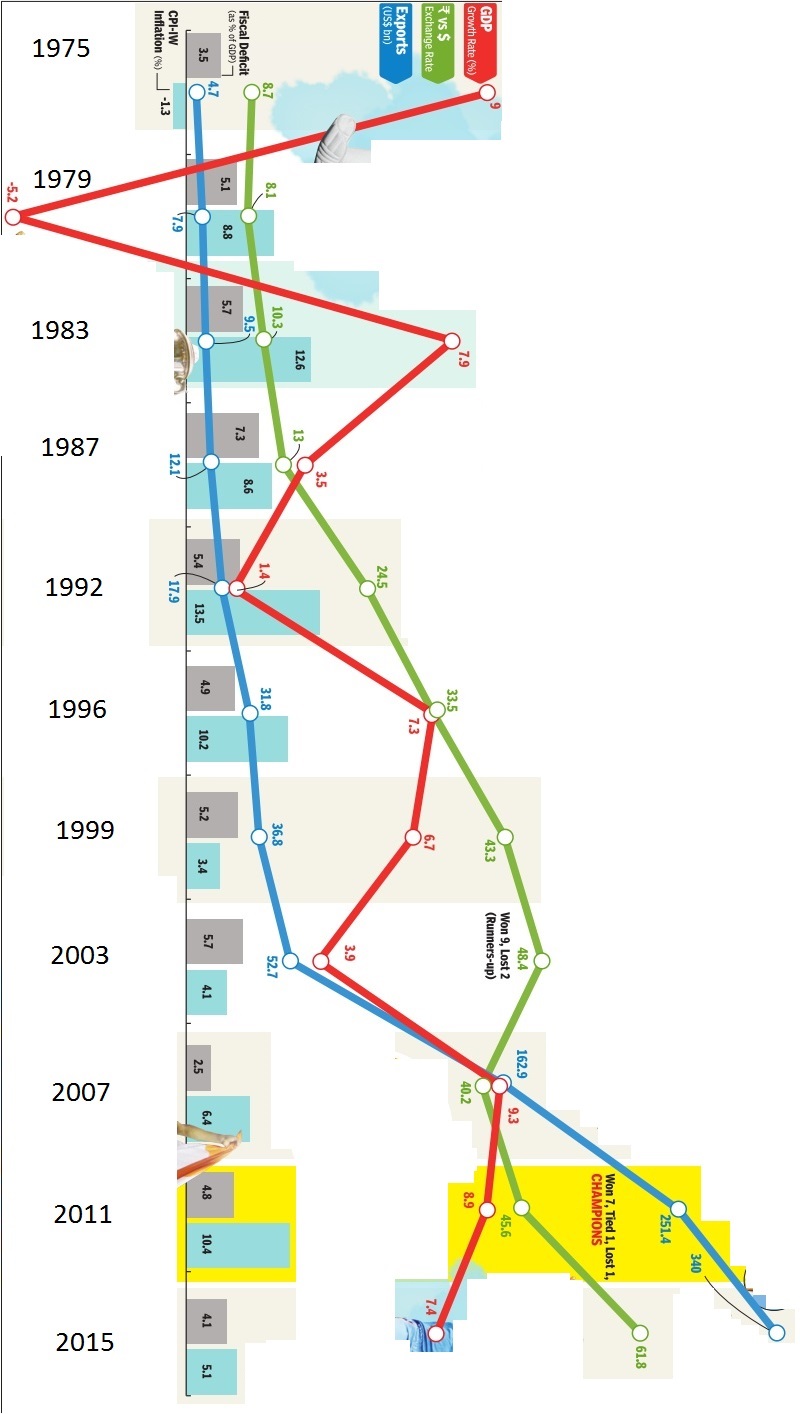
This is a collection of articles archived for the excellence of their content. |
India’s economy: the main trends from 1997 to 2017-18
1997-2018: Fiscal Deficit to GDP
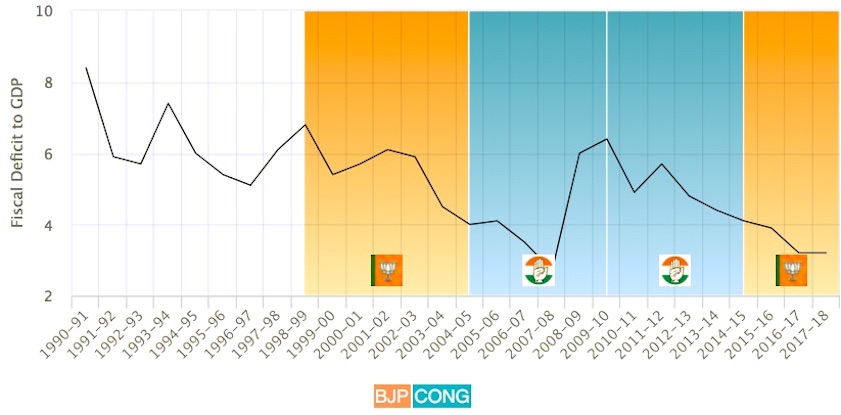
This is the size of the government’s debt as a proportion of the overall size of the economy.Data source for this chart: World Bank
From: January 29, 2018: The Times of India
See graphic:
Fiscal Deficit to GDP, 1990-2018
1997-2018: Gross Fixed Capital Formation (GFCF)
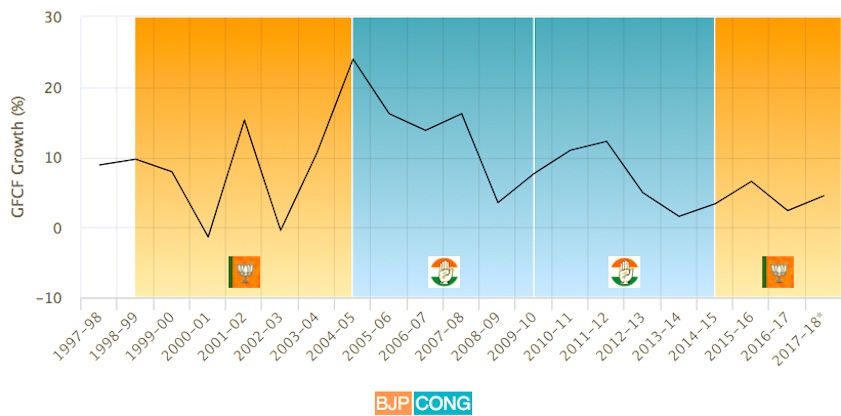
Data source for this chart: World Bank
From: January 29, 2018: The Times of India
See graphic:
Gross Fixed Capital Formation (GFCF) is an indicator of how much investment activity is happening in the country and a slowdown on this front does not bode well for overall growth and job creation- 1997-2018
1997-2018: Inflation trend
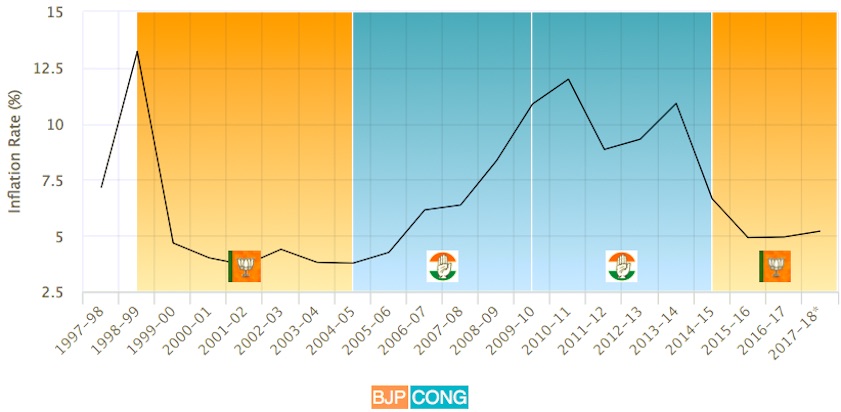
This is the rate at which the general level of prices in the economy is rising.Data source for this chart: World Bank
From: January 29, 2018: The Times of India
See graphic:
Inflation trend, 1997-2018
1997-2018: Unemployment Rate

The unemployment rate measures the proportion of people in the labour force looking for a job but unable to find one.Data source for this chart: World Bank
From: January 29, 2018: The Times of India
See graphic:
Unemployment Rate, 1997-18
The year-wise position, especially after 2002
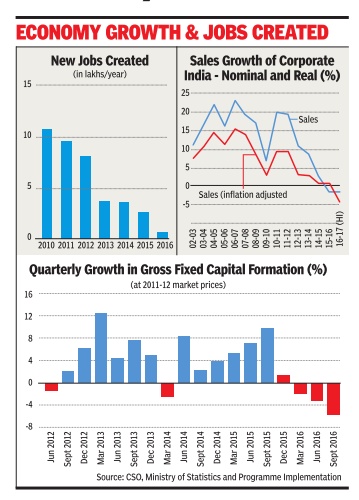
ii) Sales Growth of corporate India-Nominal and Real (%), 2002-17;
iii) Quarterly growth in Gross Fixed Capital Formation (%), Jun 2013- Sept 2016; The Times of India, January 31, 2017
2004- 18
Better growth prospects in FY19, but oil a risk: Expert, June 1, 2018: The Times of India
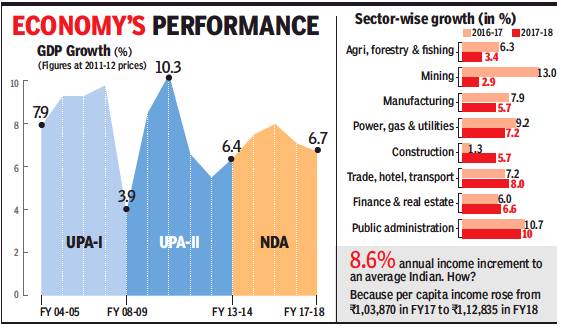
2016-18
i) Sector-wise growth, and
Growth in per capita income
From: Better growth prospects in FY19, but oil a risk: Expert, June 1, 2018: The Times of India
Economists are predicting a further pick-up in activity during the current financial year on the back of higher consumption demand, a stable GST and a surge in investment towards end of the year. But they have identified higher crude oil price and its impact on inflation, current account deficit and overall growth as risk factors that are expected to weigh on RBI’s Monetary Policy Committee (MPC), which meets next week.
Most economists are predicting a GDP growth rate of 7-7.5%, with a majority closer to the upper end of the band. A few have already lowered their projections, such as Moody’s which cut from 7.5% to 7.3%, citing the impact of crude. But others, including the government, are sticking to their earlier estimates.
“I don’t think we are revising our estimates or the forecast for the current year, which is about 7.5%. We retain it at that level... there is no one-to-one relation between the oil price growth and the GDP growth. There have been various quarters and years when oil prices have gone up but there has been growth also. So, we at this moment feel that we should retain (the growth estimate),” economic affairs secretary Subhash Chandra Garg told reporters after the GDP numbers were released.
Economists too are bullish at the moment. “The growth is likely to realise from pick-up in consumption, especially rural consumption, with the forecast of normal monsoon, increased public sector spending and uptick in performance of the manufacturing sector in coming quarters. The manufacturing sector, which witnessed improvement in the last three quarters, is expected to benefit in Q1 of FY19 due to favourable base effect. In addition, investment rate has seen some improvement on the quarterly basis and is expected to maintain the momentum going ahead,” said Madan Sabhnavis, economist at CARE, while forecasting 7.5% growth this fiscal.
Health of the banking sector will also be crucial. “The ability of public sector banks to support lending growth, the risk of monetary tightening and trade wars, and impact of higher crude oil prices on purchasing power of consumers and corporate earnings have emerged as risks,” said Aditi Nayar, principal economist at ICRA.
2004-14 vis-à-vis 2014-18
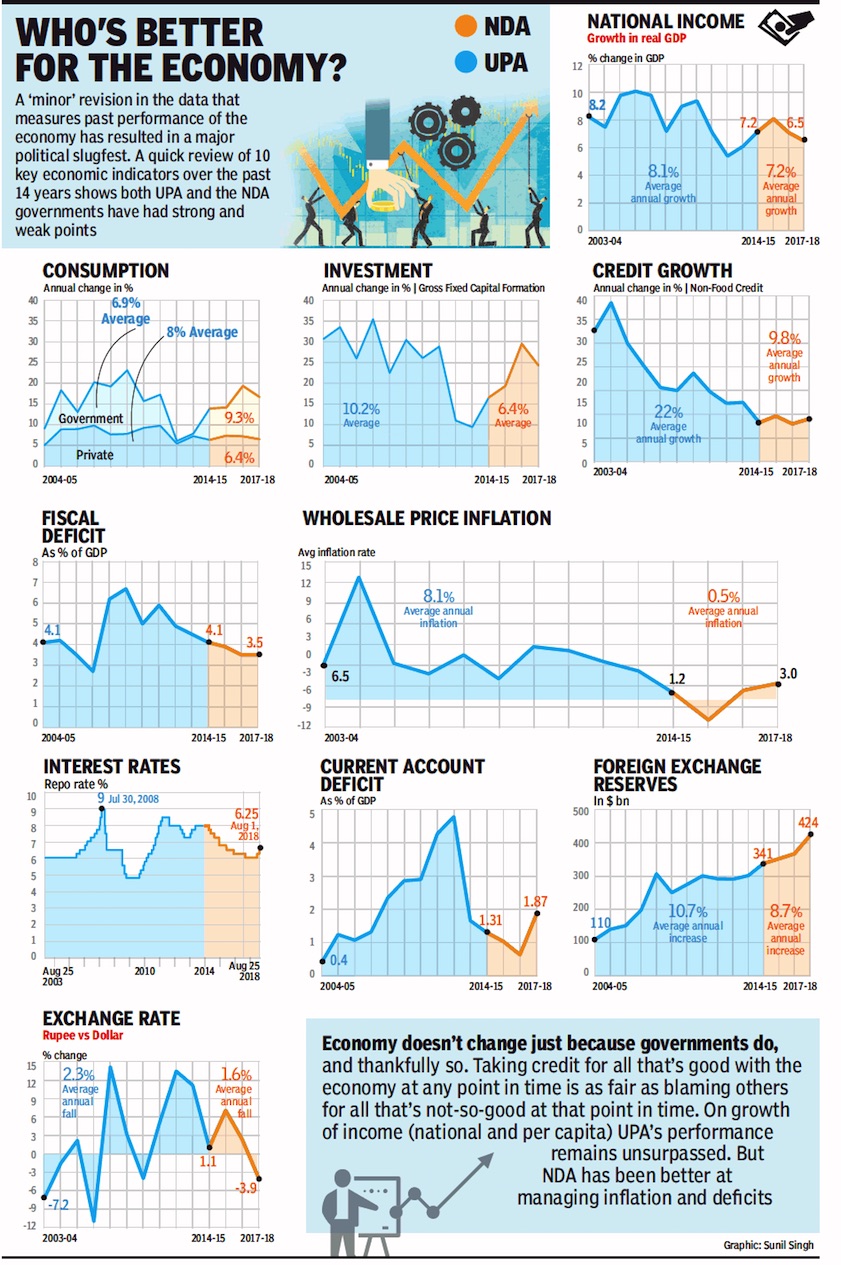
i) Consumption,
ii) Investment,
iii)Credit Growth,
iv) Fiscal Deficit,
v) Wholesale Price Inflation,
vi) Interest Rates,
vii) Current account Deficit,
viii) Foreign Exchange Reserves
From: August 23, 2018: The Times of India
See graphic:
The Indian economy in 2004-14 vis-à-vis 2014-18- Consumption, Investment, Credit Growth, Fiscal Deficit, Wholesale Price Inflation, Interest Rates, Current account Deficit, Foreign Exchange Reserves
2012-16: fastest growth in 5 years
The Times of India, Jun 01 2016
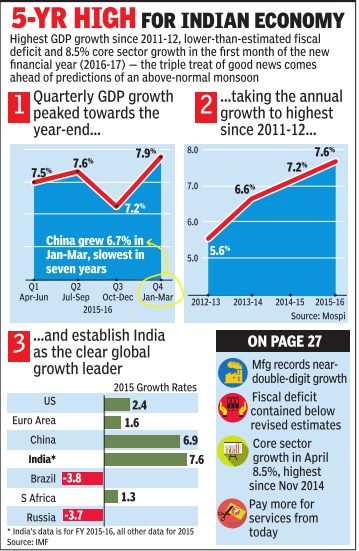
Eco grows fastest in 5 years at 7.6%
The country's economy grew 7.6% in 2015-16, the fastest in five years, while growth in the fourth quarter clocked 7.9%, keeping India ahead as the fastest growing major economy in the world.
The GDP data also brought cheers for the government, which has completed two years in office and is showcasing revival of the economy as a major achievement. India's 7.9% expansion in JanuaryMarch (fastest in six quarters) is higher than China's 6.7% expansion in the same quarter.In October-December quarter Indian economy grew 7.2%.Growth was powered by strong expansion in the manufacturing, which grew 9.3% in 2015-16 compared to 5.5% in 2014-15 and the farm sector, which clocked a growth of 1.2% in 2015-16 compared to a contraction of 0.2% in the previous year. The growth in the farm sector was despite the impact of a drought. Policy makers lauded the improving health of public finances. “.. India continues to remain a bright spot in the world economy with robust macro-economic and fiscal parameters,“ the finance mini stry said in a statement. Economist said they expect a good monsoon to support improving growth in the months ahead.
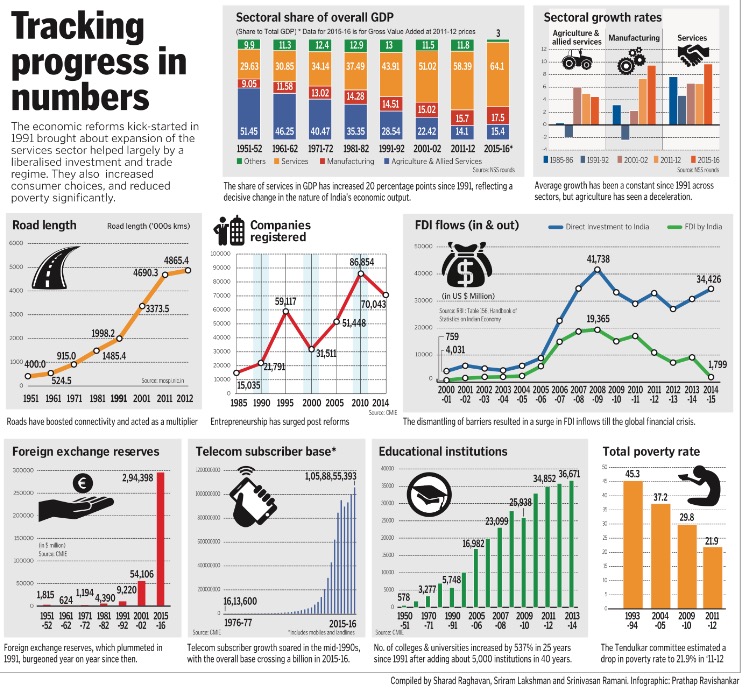
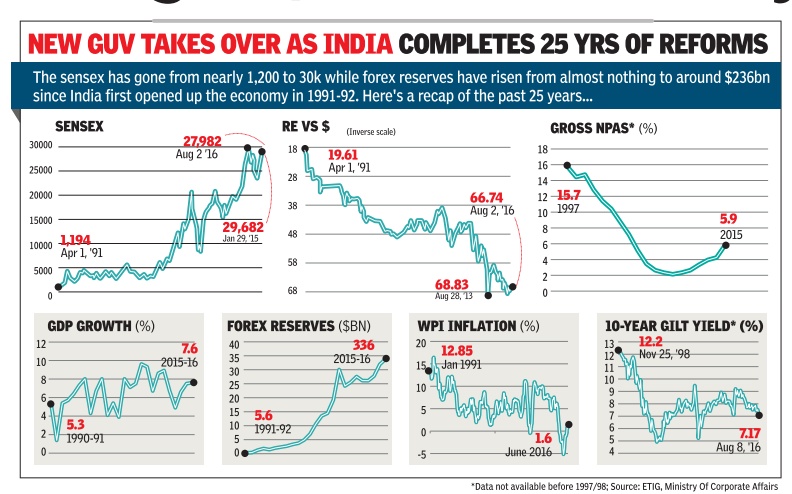
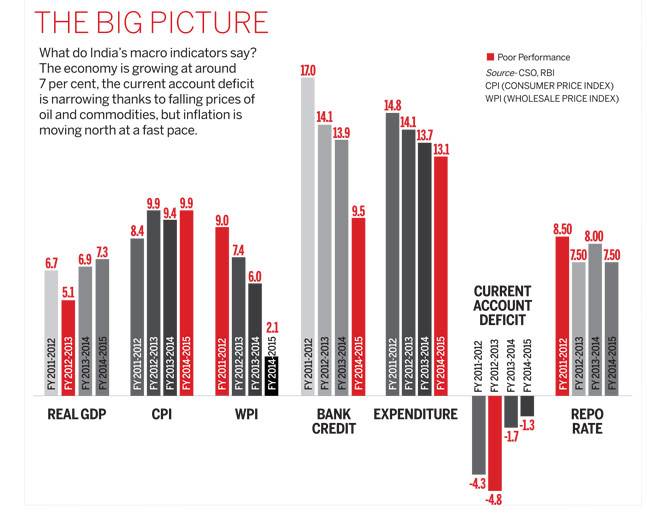
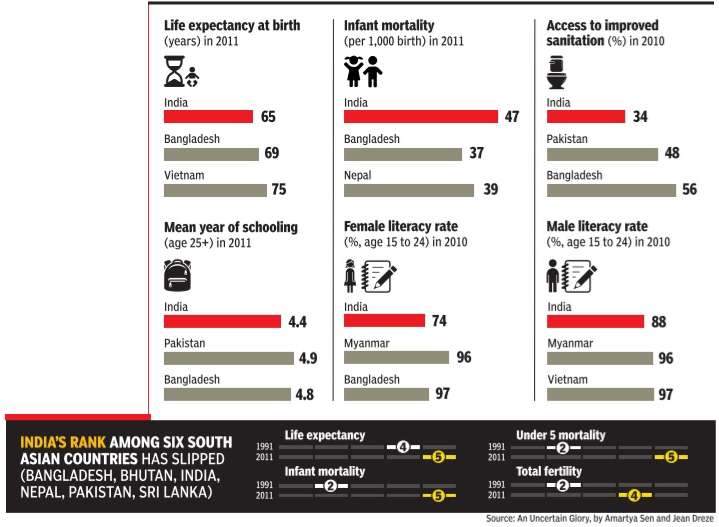
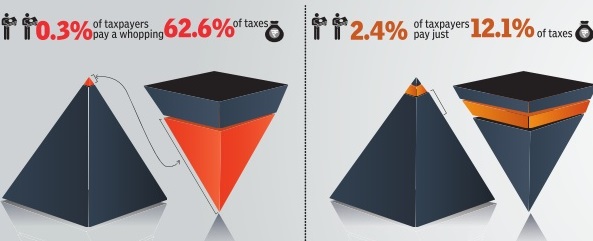



“With renewed forecast of more than normal monsoon this year, the situation in agriculture is expected to improve significantly , which will eventually lead to revival of consumption demand, especially in rural areas,“ said Madan Sabnavis, chief economist at Care Ratings.
“This in turn should also boost investment sentiment and keep food inflation under control. Also implementation of various government schemes and 7th Pay Commission will have an important bearing. With continued strong performance of the service sector, GDP growth in FY17 should see strong contributions from each sector of the economy . We expect GDP growth in FY17 to be around 7.8%,“ he said.
But the numbers also showed some weak spots such as sluggish investment growth.
“Private consumption has emerged as the bulwark of economy in 2015-16, whereas investment growth has slowed.With excess capacity and high leverage, private consumption demand will have to rise further to pare excess capacity and encourage private investment. With normal monsoon, a mild kick to public sector wages and improved transmission of interest rates, private consumption demand is set to get a boost in 2016-17,“ said D K Joshi, chief economist at Crisil.
2014-16: Economic indicators
See graphic
Economy, GDP growth, fiscal deficit, industrial growth, inflation and growth in agriculture, forestry and fishing, 2014-17
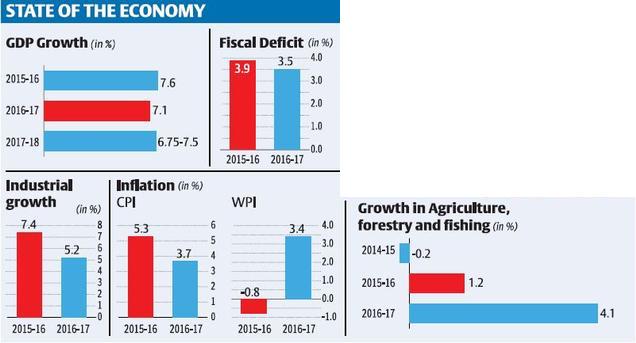
Facts about Indian economy: 2015-16
[The Economic Survey: 2016-17]
Indians on The Move

New estimates based on railway passenger traf c data reveal annual work-related migration of about 9 million people, almost double what the 2011 Census suggests.
Biases in Perception
China’s credit rating was upgraded from A+ to AA- in December 2010 while India’s has re- mained unchanged at BBB-. From 2009 to 2015, China’s credit-to-GDP soared from about 142 percent to 205 percent and its growth decelerated. The contrast with India’s indicators is striking.
New Evidence on Weak Targeting of Social Programs
Welfare spending in India suffers from misallocation: as the pair of charts show, the districts with the most poor (in red on the left) are the ones that suffer from the greatest shortfall of funds (in red on the right) in social programs. The districts accounting for the poorest 40% receive 29% of the total funding.
Political Democracy but Fiscal Democracy?
India has 7 taxpayers for every 100 voters ranking us 13th amongst 18 of our democratic G-20 peers.
India's Distinctive Demographic Dividend
India’s share of working age to non-working age population will peak later and at a lower level than that for other countries but last longer. The peak of the growth boost due to the demographic dividend is fast approaching, with peninsular states peaking soon and the hinterland states peaking much later.
India Trades More Than China and a Lot Within Itself
As of 2011, India’s openness - measured as the ratio of trade in goods and services to GDP has far overtaken China’s, a country famed for using trade as an engine of growth. India’s internal trade to GDP is also comparable to that of other large countries and very different from the caricature of a barrier-riddled economy.
Divergence within India, Big Time
Spatial dispersion in income is still rising in India in the last decade (2004-14), unlike the rest of the world and even China. That is, despite more porous borders within India than between countries internationally, the forces of “convergence” have been elusive.
Property Tax Potential Unexploited
Evidence from satellite data indicates that Bengaluru and Jaipur collect only between 5% to 20% of their potential property taxes.
2015-16: economy grew 7.9%
Eco grew 7.9% in '15-16, faster than estimated 7.6%, Feb 01 2017: The Times of India

The Central Statistics Office (CSO) said the economy grew by 7.9% in 2015-16, a shade faster than previously estimated 7.6%, on account of better perfor mance by the farm and industrial sectors. CSO, however, left the figure for 2014-15 unchanged at 7.2%.
The revised growth rate would be the fastest pace of expansion for the economy in five years as data for the new series introduced in 2011-12 is available now. It would give the government ammunition to counter the Opposition's charge that the NDA's handling of the economy has slowed down the growth rate.
CSO had said that the economy was estimated to grow 7.1% during the current financial year but did not factor in the impact of demonetisation. The Economic Survey , released on Tuesday , however, indicated that the growth rate could slip to 6.5% due to the cash squeeze.
Higher growth rate would push up the base and could result in a further slowdown during the current finnacial year. It would, however, help the government show a better fiscal performance since the base has expanded.
Separate data showed the fiscal deficit up to December-end has touched 94% of the full year estimate of Rs 5.3 lakh crore.Fiscal deficit during April-December 2015 was estimated at 88% of the budget estimate.
The economy as in 2017
The Times of India, January 31, 2017
For the first time, along with a host of numbers and dry facts, the Economic Survey presented today also highlighted seven curious things about India, ranging from a perception bias against it to a fiscal disparity within it.
1. Indians on the move
New estimates based on railway passenger traffic data reveal annual work-related migration of about 9 million people, almost double what the 2011 Census suggests.
2. Biases in perception
China's credit rating was upgraded from A+ to AA- in December 2010 while India's has remained unchanged at BBB-. From 2009 to 2015, China's credit-to-GDP soared from about 142 percent to 205 percent and its growth decelerated. The contrast with India's indicators is striking.
3. New evidence on weak targeting of social programs
The Survey says that welfare spending in India suffers from misallocation. Districts with the most poor are the ones that suffer from the greatest shortfall of funds in social programs. The districts accounting for the poorest 40% receive 29% of the total funding.
4. Narrow tax base
India has seven taxpayers for every 100 voters, ranking us 13th amongst 18 of our democratic G-20 peers.
5. India trades more than China
As of 2011, India's openness - measured as the ratio of trade in goods and services to GDP - has far overtaken China's. India's internal trade is also comparable to that of other large countries.
6. India's distinctive demographic dividend
There will a steady rise in India's working age population. While it will be slower compared to other countries, it is expected to last for much longer. Peninsular states are fast approaching the peak of the growth boost due to the demographic dividend.
7. Income divergence within India
During the last decade (2004-14), spatial dispersion in income has been on the rise in India, unlike the rest of the world and even China. Despite more porous borders within India than between countries internationally, the geographical graph of per capita income is skewed.
2012-18: impact of GST on manufacturing

From: September 3, 2018: The Times of India
See graphic:
2012-18- The impact of GST on manufacturing
Economic indicators: 2012-14 vs. 2014-17
See graphics:
1. GDP growth, 2011-17, year-wise and % annual rise in per capita income at current prices, 2012-17, year-wise
2. Inflation dynamics, 2011-17, year-wise and merchandise exports, 2011-17, FDI inflows, 2013-17, Industrial production, 2012-17, year-wise
3. Fiscal deficit, 2011-17, total tax revenue, 2012-17, fluctuations in stock market (BSE), 2011-17, year-wise
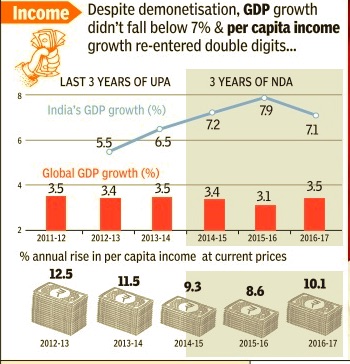

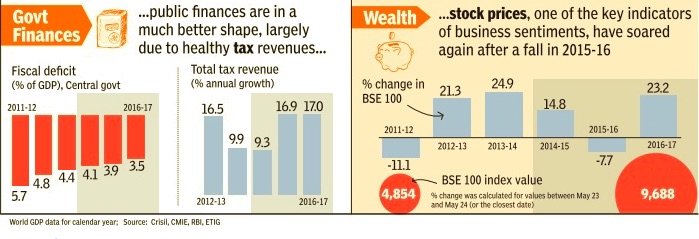
Indicators 2013-18 (inflation, monsoons, crude prices)

ii) Performance of monsoons, 2008-17;
iii) Value of rupee, Jan- June, 2018;
iv) Crude oil prices, 2013-18
From: June 8, 2018: The Times of India
See graphic:
i) Inflation in India (CPI): 2013-18;
ii) Performance of monsoons, 2008-17;
iii) Value of rupee, Jan- June, 2018;
iv) Crude oil prices, 2013-18
2014, May- 2018, May
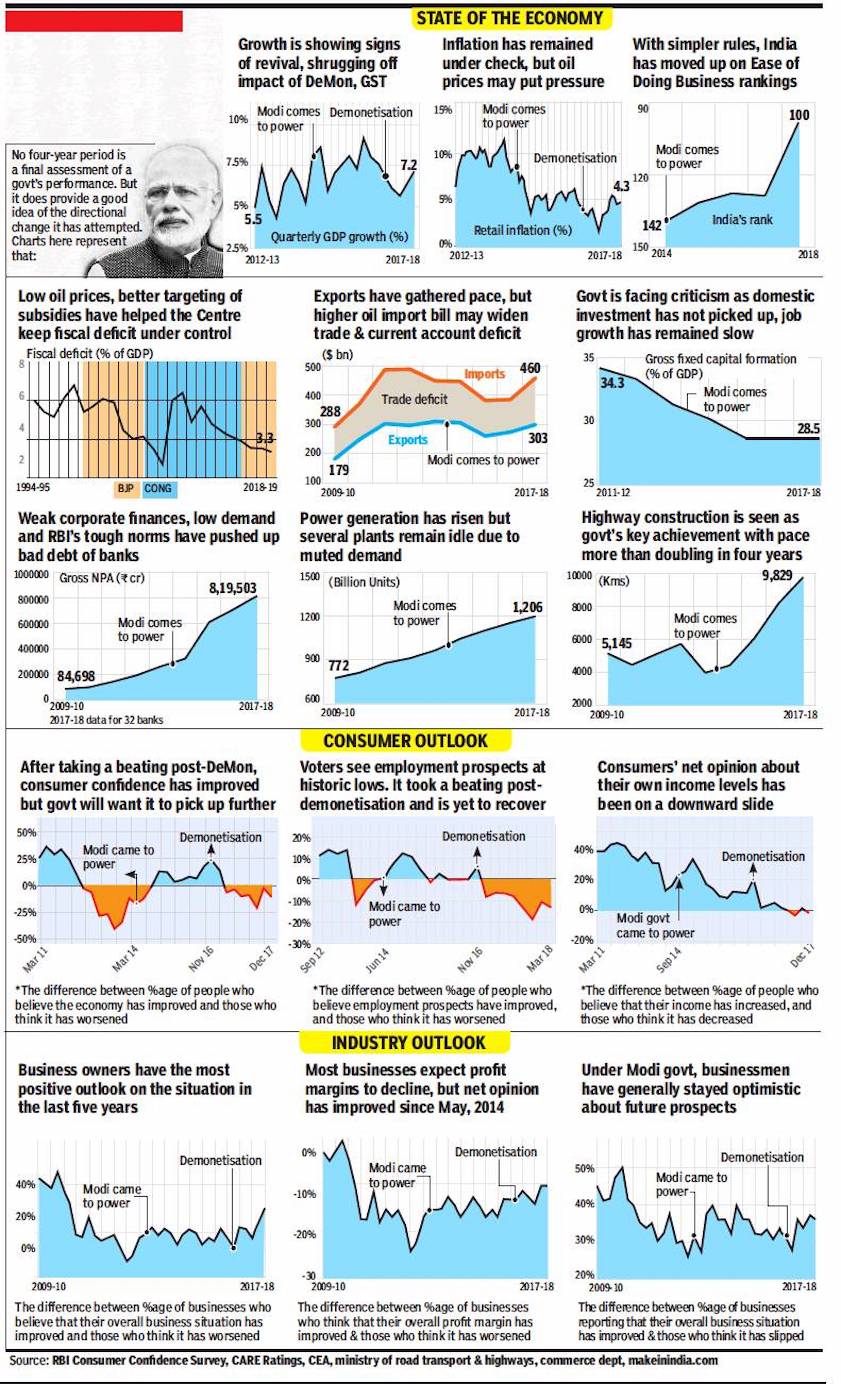
From: May 26, 2018: The Times of India
See graphic:
Four years of Modi government an economic report card
Oct 2016- Jan 2018: industry, manufacturing, inflation
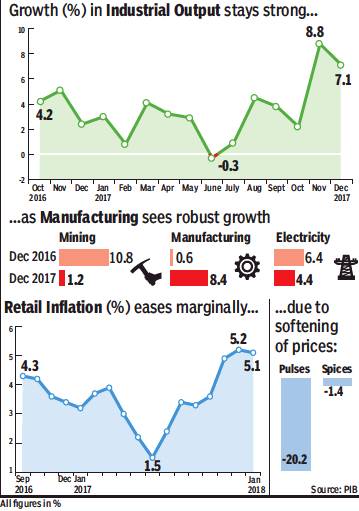
From: Retail prices ease, factory output beats expectations, February 13, 2018: The Times of India
Retail prices ease, factory output beats expectations, February 13, 2018: The Times of India
Retail inflation cooled in January on the back of slowing food prices, while industrial output growth in December was better than expected, thanks to robust manufacturing and capital goods sectors.
Data released by the Central Statistics Office (CSO) on Monday showed inflation, as measured by the consumer price index (CPI), rose an annual 5.1% in January, slower than previous month’s 5.2%. Consumer food prices also cooled and increased 4.7%, lower than near 5% increase in December. Housing prices remained firm, and surged 8.3% during the month.
Earlier this month, RBI kept interest rates unchanged and flagged risks to inflation from several factors, including the government missing the fiscal deficit target for 2017-18. Economist said inflation in non-food items continues to be worrisome, with clothing and footwear
(4.7%), housing (8.3%), fuel
(7.7%) household goods
(4.9%), all being high.
“However, elevated fuel prices and the base effect will keep CPI inflation in the vicinity of 5% for the rest of the year till March,” said Madan Sabnavis, chief economist at Care Ratings, adding that cooling food prices will have a calming effect on retail inflation.
Separate data released by the CSO showed industrial output growth rose 7.1% in December, slower than previous month’s upwardly revised 8.4% but still higher than market expectations. The manufacturing sector rose an annual 8.4% in December, compared to 0.6% in same month last year.
Several data sets in the past few months have pointed to a revival in the manufacturing sector as it shrugs off the impact of demonetization and rollout issues linked to the GST. Economist said the robust trend in factory output augured well for overall growth.
“Higher growth in vehicles and transport bodes well for the economy. We expect IIP growth to trend higher in January also as commercial vehicle sales have expanded by 36.6%. The positive contribution of cement, diesel and even two wheelers augurs well for economic recovery, especially for rural economy,” said Soumya Kanti Ghosh, group chief economic adviser at SBI.
2018 Aug vs. June: mixed trends

From: October 1, 2018: The Times of India

From: October 1, 2018: The Times of India
See graphics:
The growth of the Indian economy, June, July, Aug 2018: Passenger vehicles, Commercial vehicles, CIL output, Non-oil export
The growth of the Indian economy, June, July, Aug 2018: Rail freight, Airlines, Petrol, Bank deposits, Non-food bank credit
Balance of payment/ current account deficit
2016-2017
Deficit widens due to lower remittances, March 24, 2017: The Times of India
Remittances from overseas Indians has been dropping continuously for the last five quarters, contributing to the widening of current account deficit (CAD). The trade gap has also widened due to lower software exports.
Balance of payment data released, shows that net personal transfers -which are largely remittances by Indians employed overseas--fell to $13.6 billion during the demonetisation quarter from $14.9 billion, a drop of 9.7%.
According to numbers released by the RBI, the current account deficit widened to $ 7.9 billion (or 1.4% of GDP) in Q3FY17 as compared to $ 7.1 billion (1.4% of GDP) in Q3FY16 and $ 3.4 billion in (0.6% of GDP) in Q2FY17. The CAD is the difference between income from exports and imports, plus the difference from between outbound and inbound investment income.
A statement issued by the Central bank said that the CAD widened despite a slightly lower trade deficit year-on-year, primarily on account of a decline in net invisibles receipts. Invisible includes remittances from software, services and money sent by Indians working oversea. Net services receipts moderated compared to Q3FY16, due to a fall in earnings from software, finan cial services and charges for intellectual property rights.
From April to December, however, the deficit halved to 0.7%, from 1.4% a year ago.
This was primarily because of fall in earnings from software, financial services and charges for intellectual property rights.
Earnings from software exports have been declining year-on-year, but the third quarter has seen a sequential increase in software exports over the second quarter.
The net foreign direct investment of $9.8 billion during the reporting quarter was marginally lower than last year. The RBI said that there was a net outflow of portfolio investment of about $11.3 billion during the period in both equity and debt segments, as against a net inflow of $0.6 billion in the year-ago period. During the current fiscal, net FDI rose 12.3% to $30.6 billion as compared to April-December 2016.
Governments and economic growth
1947-2018: India has performed better under ‘weak’ governments
According to the World Poverty Clock, an online database… About 41 Indians escape extreme poverty every minute.
India’s achievement is creditable by any yardstick. But it occurs against a backdrop of rising prosperity worldwide.
A political paradox of sorts has accompanied India’s upward economic arc. For the first four decades of independence, single-party majority governments delivered anaemic growth. India’s most dramatic assault on poverty has come in the coalition era that followed Rajiv Gandhi’s defeat in the 1989 general election.
Between 1950 and 1980, India’s economy expanded at an annualised average of 3.6%. Per capita income grew at a sluggish 1.5% per year. These figures ticked upward in the 1980s, but the real breakthrough only came after India embraced liberalisation and globalisation in 1991. Since then per capita income has grown on average by 4.9%. Since 2004, it has grown even faster – by over 6.1% annually. In this period, India has lifted more than 350 million people out of extreme poverty.
Why did weak governments deliver better results than strong ones? The simple answer: in India, the era of single-party majorities coincided with the heyday of state planning. After Independence, instead of embracing a market economy, where supply and demand determine production, India scurried down the rabbit hole of socialism where pointy-headed bureaucrats and their political masters called the shots.
Under both Jawaharlal Nehru and Indira Gandhi the government raised trade barriers, nationalised private enterprises, raised extortionate taxes on the rich, and told companies how to run their business. Had they instead used their power to build infrastructure, strengthen rule of law, encourage private enterprise and educate the masses, India need not have waited this long to nearly wipe out poverty.
But as four years of Modi have shown, a strong government’s tendency to overreach remains a recurring national problem.
Only a strong government could have come up with a cockamamie idea like demonetisation, deemed too crazy to try even by a basket case economy like Venezuela. In a less dramatic – but nonetheless destructive – vein the Modi government has armed tax inspectors with extortionate powers, escalating the tax terrorism the Bharatiya Janata Party (rightly) protested when in opposition.
On trade, tariff-loving bureaucrats have prevailed over liberalisers. And while an elegant simplicity marks a goods and services tax in most countries that have adopted it, in India it’s a hot mess designed to privilege discretion over clarity.
The writer is a resident fellow at American Enterprise Institute in Washington, DC.
India's economy vis-à-vis the world
See Gross domestic product (GDP): India
Economy, India: international comparisons
2016 : Demonetisation
Please see:
Demonetisation of high value currency- 1946, 1978: India
Demonetisation of high value currency- 2016: India
See also
Economy: India 1
Economy: India 2 (Ministry data)
Economy, India: international comparisons
Gross domestic product (GDP): India
Per capita Income: India and its states
And also...
Income Tax India: Expert advice, 2016-17
Income Tax India: Expert advice, 2017-18